Learn
Visualizing and Retrieving Fingerprints
Prints that are left at a crime scene can be deposited in different ways. Some are visible but others can only be seen through enhancement.
Types of Prints
One type of visible print is made when a finger touches a soft material such as putty, wet paint, or soap and leaves behind a 3-dimensional indentation. These are known as plastic prints.
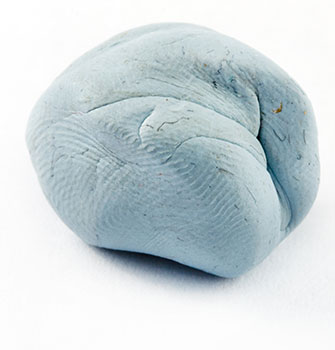
Another type of visible print is created when the finger encounters a colored material and then transfers it to another surface, creating a patent print. Patent prints can be made from blood, dirt, paint, or ink.
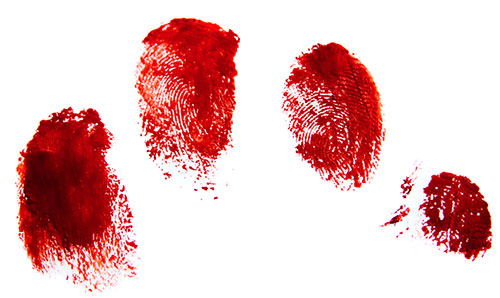
Both plastic and patent prints are collected using photography. The prints are photographed in high resolution with a measurement scale included for reference. Sometimes additional lighting, chemicals or dyes may be used but this is typically not necessary for visible prints.
Most prints, however, are not visible without enhancement. These are known as latent prints and are caused by the transfer of body oils and sweat to the surface of an object. There are several ways to detect and collect these prints. In general, the smoother and less porous a surface is, the more likely it is that prints can be successfully found and developed.
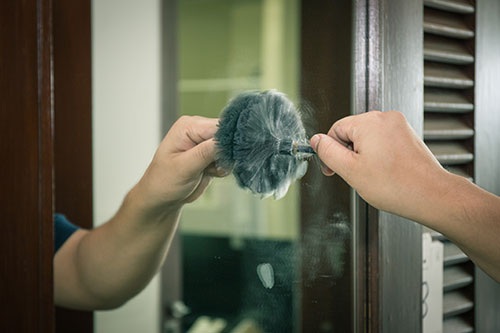
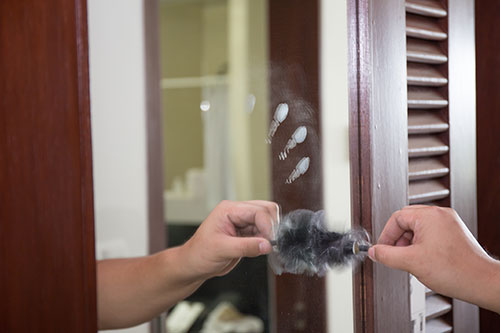
Collecting Latent Prints
Dusting
One of the most common methods for discovering and collecting latent fingerprints is by dusting a smooth or nonporous surface with fingerprint powder (black granular, aluminum flake, black magnetic, etc.). If any prints appear, they are photographed as mentioned above and then lifted from the surface with clear adhesive tape. The lifting tape is then placed on a latent lift card to preserve the print.
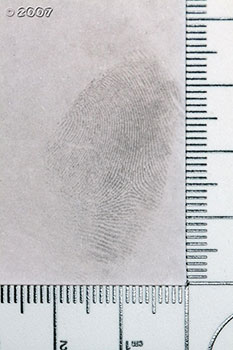
However, fingerprint powders can contaminate the evidence and ruin the opportunity to perform other techniques that could turn up a hidden print or additional information. Therefore, investigators may examine the area with an alternate light source or apply cyanoacrylate (super glue) before using powders.
Alternate Light Source
It is becoming more commonplace for investigators to examine any likely surfaces (doors, doorknobs, windows, railings, etc.) with an alternate light source (ALS). These are laser or LED devices that emit a particular wavelength, or spectrum, of light.
Some devices have different filters to provide a variety of spectra that can be photographed or further processed with powders or dye stains. For example, investigators may use a blue light with an orange filter to find latent prints on desks, chairs, computer equipment or other objects at the scene of a break-in.
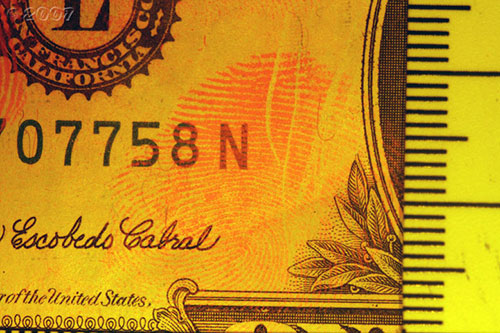
Knowledge Check #1
Which of the following, if available, should be performed first?
- Dust for fingerprints.
- Use alternate lighting to reveal fingerprints.
Answer: b. Use alternate lighting to reveal fingerprints. Dusting can destroy evidence and eliminate the opportunity for further investigation of that material.
Cyanoacrylate
Investigators often perform cyanoacrylate (superglue) processing, or fuming, of a surface before applying powders or dye stains. This process, typically performed on non-porous surfaces, involves exposing the object to cyanoacrylate vapors. The vapors (fumes) will adhere to any prints present on the object allowing them to be viewed with oblique ambient light or a white light source.

This video shows how Denver Police utilize superglue processing. Watch from the beginning to 1:18.
Open Inside the Crime Lab: Latent Print Unit in a new tab
Knowledge Check #2
From the video, how is the evidence treated following the superglue chamber?
- Cleaned with alcohol
- Sprayed with a stain
- Viewed under a microscope
Answer: b. Sprayed with a stain
Chemical Developers
Porous surfaces such as paper are typically processed with chemicals, including ninhydrin and physical developer, to reveal latent fingerprints. These chemicals react with specific components of latent print residue, such as amino acids and inorganic salts.
- Ninhydrin causes prints to turn a purple color, which makes them easily photographed.
- DFO (1,2-diazafluoren-9-one) is another chemical used to locate latent fingerprints on porous surfaces; it causes fingerprints to fluoresce, or glow, when they are illuminated by blue-green light.
Paper treated with ninhydrin reagent reveals latent prints after being processed with a household steam iron.
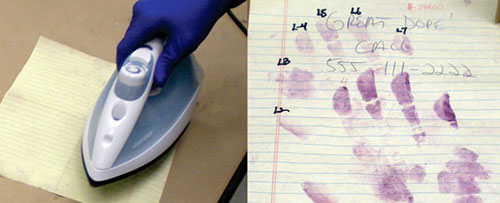
Other Collection Methods
In addition to the methods previously identified, there are special techniques for capturing prints from skin, clothing, and other difficult surfaces.
- Amido Black, a non-specific protein stain that reacts with any protein present, is typically used for developing or enhancing bloody impressions on human skin.
- To reveal prints on clothing, high-tech methods such as vacuum metal deposition using gold and zinc are showing promise for the investigator.
Chemical Processing
Chemical Processing for Latent Prints from the National Forensic Science Technology Center summarizes a variety of the chemicals used to process latent prints, describing the surfaces that the chemicals work well on, what type of alternate light source (ALS) is required, as well as the light filter that should be used for photographing the prints. This processing is typically done in the laboratory, as many of the chemicals are flammable or toxic. These precautions are included in the table.
Knowledge Check #3
According to the Chemical Processing for Latent Prints chart, which chemical is best to use to develop prints on a plastic bag?
- Small particle reagent
- Sudan black
- Rhodamine 6G
- It is not possible to process prints on a plastic bag.
Answer: b. Sudan black
Knowledge Check #4
According to the Chemical Processing for Latent Prints chart, what precautions should be taken when working with amido black?
- Gloves
- Eye protection
- Mask
- Fume hood, if available
- All of the above should be used when working with amido black.
Answer: e. All of the above should be used when working with amido black.
Like fingerprint powders, chemical processing can reduce the investigator's ability to perform other techniques that could reveal valuable information. Therefore, any nondestructive investigations are performed before the evidence is treated with chemicals. For example, a ransom or hold-up note will be examined by a questioned documents expert before being treated with ninhydrin, since some formulations of ninhydrin will cause certain inks to run, thus destroying the writing.
New Methods
Scientists are continually working to develop new methods to visual prints with even greater detail. This video shows one such method, inspired by the intricate eyes of a fly.
Open A New Way to See Fingerprints in a new tab
Knowledge Check #5
How is CTF better than current methods to develop fingerprints?
- The machine is smaller and portable.
- The process is quicker.
- More ridges and details are revealed.
- It can process fingerprints at the scene of the crime.
Answer: c. More ridges and details are revealed.
Credits
NFSTC. "How It's Done: Fingerprint Analysis." A Simplified Guide to Crime Scene Investigation, National Forensic Science Technology Center, September 2013, http://www.forensicsciencesimplified.org/prints/how.html.